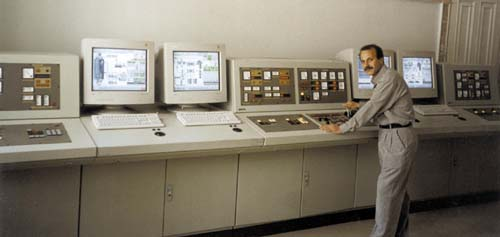
The Engine Room Simulator has been developed for the education, training and assessment of engine department personnel, including officers in charge of watch, second and chief engineers.

The wide application capabilities of the Transas ERS4000 simulator make it the correct solution for maritime colleges and academies, training centers, maritime authorities, crewing.
Technical capabilities of the ERS4000 simulator and various combinations of control and monitoring modes ensure three main training levels as per the international requirements of the STCW’95 Convention:
- familiarisation and study level;
- watchkeeping procedures in the standard modes of the systems and equipment operation;
- watchkeeping in the emergency modes with faults and failures available.
Advantages:
The simulator has the following key advantages:
- complete range of functions for education, training and assessment activities;
- individual, group and team training under Instructor supervision or without it;
- powerful Instructor Station capabilities;
- high-level of modeling – behavioral realism;
- ship-like equipment interface – physical realism;
- user-friendly system design;
- modular software structure open for customisation and future upgrades;
- instructor training programs;
- comprehensive courseware;
- possible integration with Transas shiphandling simulator.
AREAS OF APPLICATION
Education:
- Basic physical and technical knowledge
- Engine room equipment familiarisation
- System layout and flow diagrams
- Control, Automation, Alarm and Safety systems
- Operational instructions
- Watchkeeping procedures
Training:
- Updating of seagoing engineering personnel
- Educating specialists from other related qualifications
- Refresher courses
Assessment of competence:
- Issue of qualification certificates
- Diploma revalidation and qualification
- Demonstration of professional competence
Compliance with standards:
ERS4000 meets the requirements of the STCW ’95 Convention and Code. The simulator’s scope of training objectives corresponds to the specifications of standard competence for engine department personnel as to Chapter III of STCW ’95, IMO Model Courses 2.07; 2.08; 7.02; 7.04; and facilitates marine engineering training at the operational, management and support levels.
TRAINEE WORKPLACE SCREENS:
Main engine and attendant subsystems:
- Propulsion Remote control
- Fresh water cooling system;
- Sea water cooling system;
- Lubrication system;
- Fuel oil transfer system;
- Fuel oil supply system;
- Compressed air system;
- Exhaust gas and turbocharger system;
- Cpp control system, reduction gear, clutch and stern tube;
- Combustion process in the cylinders (“Cylinder diagram”).
Ship electric power plant:
- Diesel Generators (№1 and №2);
- Turbo Generator;
- Shaft Generator;
- Emergency Generator;
- Shore Supply;
- Main and Emergency Switchboards;
- Consumers, Feeders, Earth monitoring etc.
Auxiliary systems:
- Steam Plant;
- Steam Turbine;
- Steering Gear;
- Bilge Water System;
- Water Desalination Plant;
- Fire system;
- Fire Alarm station;
- Fire Main system;
- Fire CO2 system;
- Provision Cooling system (Refrigeration Plant);
- Air Conditioning system.
All the three modules can be used independently of each other or jointly.
Safety and Alarm system
ERS4000 incorporates an up-to-date simulated ship alarm system with visual and acoustic signals and automatic logger, as well as a powerful Safety system with Slowdown and Shutdown functions. These systems are essential for the training of emergency situations and equipment failures on all types of Engine Room equipment.
Simulated hardware
To simulate the vessel’s interior with greater realism and thus further improving the efficiency of training, ERS4000 can be supplied with full-size control consoles comprising built-in monitoring and control panels, as well as computers.
The hardware consoles included in ERS4000 imitate:
- integrated engine control room control desk;

- main switchboard and emergency switchboard of the ship electric power plant;
- engine room local control stations;
- monitoring and control panels ensure inspection of the majority of simulator systems and their control;
- alarm panels;
- sound system imitating sounds and noises of all the major engine room devises, as well as alarm sound signals.
All sets of ‘real’ consoles supplied with ERS4000 are provided with built-in computers connected to a local network, which ensures the full interactivity between all the components of the simulator.
3D (Virtual Reality) Engine Room
- ‘3D Virtual Reality’ engine room area for familiarisation support;
- system mnemonic diagrams and local control places
- standard operation and advanced operation including troubleshooting;
- familiarisation with engine room sounds.
Instructor workplace
The ERS 4000 Instructor software supports:
- exercise editor operation;
- “briefing” mode;
- “on-line control mode” for the simulator
- class – monitoring of the exercise fulfilment and prompt instructor input;
- exercises with scenarios;
- slave monitor for monitoring the trainee’s performance;
- “debriefing” mode – post-exercise analysis of trainee’s performance.

The instructor program main window includes: simulator controls, data (parameters) monitor, list of current alarm system signals, events and actions monitor, current scenario window, trainee selection buttons.
CONFIGURATIONS:
ERS 4000 SOLO (single-PC desktop system)
- Designed for self-education, equipment familiarisation and knowledge refresher training
- Run on standalone PC
- Off-line Instructor functions include Exercise Editor and Debriefing
ERS 4000 NETWORK CLASS (PC-based simulator class)
- Designed for Group and Team training
- Instructor control and monitoring
- Up to 12 interactive Trainee workstations

ERS 4000 FULL-MISSION (“Real” Engine Room Consoles supplied with the Trainee workstation)
- Designed for professional hands-on simulator training, including advanced operation and troubleshooting tasks
- “Real” simulated consoles with built-in monitoring and control panels
- Panels are available for Ship’s Diesel Propulsion Plant with Auxiliary systems and machinery and for Ship’s Electric Power Plant
- Full interaction between simulator software and hardware
- Any combination of ERS4000 Network and Full-mission workstations

- training of efficient and well-coordinated cooperation between the engine room and ship’s bridge crews as it is on the actual ship;
- understanding of the complexity of all onboard equipment and interactions;
- training in emergency situations;
- advanced equipment familiarisation necessary due to the increased level of automation on modern ships, where more engine monitoring
- and control devices are installed on the bridge (in accordance with the IMO ‘Watch 1’ standard).

Application:
- maritime simulator centres and schools providing training for dual qualification specialists (navigator/engineer);
- shipping companies arranging training for the ship’s crews.